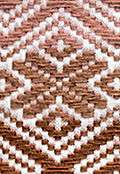Inkle weaving
Inkle weaving is a type of warp-faced weaving where the shed is created by manually raising or lowering the warp yarns, some of which are held in place by fixed heddles on a loom known as an inkle loom. Inkle weaving was referred to in Shakespeare's Love's Labour's Lost. It was brought to the United States in the 1930s, but predates this by many centuries in other countries. The term "Inkle" simply means "ribbon" or "tape" and probably refers to a similarly structured woven good that could have been made on different types of looms, such as a box-loom.
Inkle weaving is commonly used for narrow work such as trims, straps and belts.
Equipment

Inkle looms are constructed in both floor and table-top models. Either model is characterized by a wooden framework upon which dowels have been fastened. These dowels will hold the warp threads when the loom has been dressed.

One of the dowels, or a paddle, is constructed so that its position can be adjusted. This tensioning device will be taken in as weaving commences and the warp threads become shorter.
Additional equipment includes yarn of the weaver's choice, yarn or thread for forming heddles and a shuttle to hold the weft. A notebook is also handy for charting weaving diagrams.
Process
The inkle loom is threaded with warp threads according to the weaver's design, alternating between yarn that can be raised and lowered and yarn that is secured in place through the use of the heddles. The raising and lowering of these warp threads creates the shed through which the weft thread will be carried on a shuttle. The weaver should make one pass with the shuttle with each opening of a shed through the raising and lowering of threads.
A simple raising and lowering of threads creates a plain-weave band in which warp threads are slightly offset. Weft threads are only visible at the edges of the band and the weaver may wish to take this into account by warping threads that will form the edges in the same color as the weft.
As the weaving commences, the warp threads will shorten on the loom and the weaver will need to adjust the tension periodically. As the inkle band progresses, it will also get closer to the heddles. The weaver will also need to advance the warp thread along the bottom of the loom to open up new weaving space. In her book "Inkle Weaving," Helene Bress recommends loosening the tension when you are ready to advance the warp. Once you have done so, tighten the tension again and resume your weaving.
There are other more advanced techniques in which, instead of merely allowing warp threads to alternate in their up or down positions, individual threads are brought to the surface to form what is called a "pick up" pattern. One side of the band will show the exposed surfaces of warp threads while, on the other side of the pattern, the weft thread will be visible. Using a supplemental weft thread that will come up over the top of certain warp threads, brocaded designs can also be worked into the inkle band.
An inkle loom is also useful in the practice of tablet weaving for its added portability. Simply thread the warp onto the loom but use cards instead of alternating between free-hanging and heddle-secured yarn.
Uses for inkle weaving
Inkle bands are quite strong and can be used in applications where a flat band is desired. Popular modern uses are guitar and camera straps, or, for particularly narrow bands, colorful shoelaces. Traditionally inkle weaving also served as belts and reins. Re-enactors use it as trim for garments and other textiles.
Recommended reading
- Bress, Helene. Inkle Weaving. Flower Valley Press / Scribner, 1975, ISBN 0-9620543-1-3
- Brown, Rachel. The Weaving, Spinning, and Dyeing Book Second Edition Alfred A. Knopf, New York, 1983, ISBN 0-394-71595-0
- Dixon, Anne. The weaver's inkle pattern directory : 400 warp-faced weaves. Interweave Press, Loveland, CO, 2012. ISBN 9781596686472
- Folts, Teressa. The inkle path to weaving Serenity Weavers, 1977.
- Holland, Nina. Inkle loom weaving Watson-Guptill Publications, 1973. ISBN 0-8230-2551-9
- Holland, Nina. The Weaving Primer : A complete guide to Inkle, Backstrap, and Frame Looms Chilton Book Co., 1978. ISBN 0-8019-6625-6
- Tidball, Harriet. Weaving Inkle Bands Shuttle Craft Books Inc. 1969. ISBN 0-916658-27-9
- Sutton, Ann & Collingwood, Peter. The craft of the weaver Lark Books, 1983. ISBN 0-937274-10-0
See also
External links
- History of Inkle weaving [dead link]
- Free Inkle Weaving Class [dead link]
- Weaving on an Inkle Loom http://www.weavezine.com/content/weaving-inkle-loom
